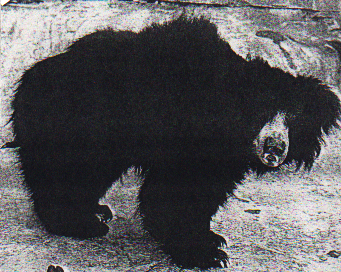 Marshall
Cultural Atlas Marshall
Cultural Atlas
This collection of student work is from
Frank Keim's classes. He has wanted to share these works for others
to use as an example of Culturally-based curriculum and documentation. These
documents have been OCR-scanned. These are available
for educational use only.
Sloth Bear
The history of the Sloth bear leads back to the eighteenth century
when the first pelts of this bear arrived in Europe. These bears were
shot by big game hunters in India, and it was said that they had
turtleneck snouts. These animals were also reported to hang upside
down from branches for long hours on end. People that saw these bears
said that they cried like babies.
A doctor by the name of George Shaw of the British Museum
was so impressed by the details of this bear that he decided to study it
to
find out more information about it. At first this bear had been
classified with sloths because of its long sickle shaped claws. But
in 1819, when a live specimen reached Paris, it was realized that
this animal wasn't a sloth but a true bear. That was when the name "bear sloth" was quickly changed to "sloth bear".
This bear has a long, shaggy, unkempt, black coat, with a white Y
marking on its chest. Its hair is much longer than that of any other
bear. It has most of its hair around the neck and the shoulders.
Underneath the shaggy hair it has no hair, to keep it cool.
A Sloth bear has a muzzle with extremely protrusive lips and
nostrils. It is much like an anteater. It likes to eat termites. Its
hairless nose helps it suck termites in. This is their main source of
food.
When this bear is just walking around it may be three feet long,
but when
standing it's six feet tall. The feet consist of white, blunt,
curved claws up to three inches long. The tail is much longer than
any other bear's. Male Sloth bears weigh about 300 pounds, and
females weigh less.
These bears are found on the islands of Sri Lanka and on the
Indian subcontinent, around the north part of the Himalayas, and east
of Assam. Some people have seen them in a Nepal park called Chitwan
National Park.
These bears are active all the time. They walk very slowly, but
they can gallop as fast as a walking person.
When this bear meets danger it does not hide. It can be very
dangerous to be around when it is mad.
These bears like the company of other Sloth bears. They
communicate with facial expressions, strange roars, howls, squeals,
yelps, huffs, rattles and gurgles. When mating they are very noisy.
When they sleep they are also noisy. Male bears mark trees when they
are ready to mate.
Sloth Bears do not sleep at all during the winter, like other
bears. These bears are not considered game animals. They are only
killed if they get into someone's crops and eat their produce. The
real danger to this bear is the destruction by humans of their
habitat.
The Sloth bear is estimated to have a population ranging from
7,000 to 10,000, but it is also disappearing very fast. In the Bengal
Tiger Reserve this bear is increasing, however.
by LaVerne J. Manumik

Sloth Bear
Bear Fire
Stories and Poems
about Bears
|
by Marshall High School
Language Arts Classes
Spring, 1992
Produced
by
Information
about Bears
Creative
Stories from the Imagination
True
Stories from Experience
Poems
Christmastime Tales
Stories real and imaginary about Christmas, Slavik, and the New Year
Winter, 1996 |
Christmastime Tales II
Stories about Christmas, Slavik, and the New Year
Winter, 1998 |
Christmastime Tales III
Stories about Christmas, Slavik, and the New Year
Winter, 2000 |
| Summer Time Tails 1992 |
Summertime Tails II 1993 |
Summertime Tails III |
| Summertime Tails IV Fall, 1995 |
Summertime Tails V Fall, 1996 |
Summertime Tails VI Fall, 1997 |
| Summertime Tails VII Fall, 1999 |
Signs of the Times November 1996 |
Creative Stories From Creative Imaginations |
| Mustang Mind Manglers - Stories of the Far Out,
the Frightening and the Fantastic 1993 |
Yupik Gourmet - A Book of
Recipes |
|
| M&M Monthly |
|
|
| Happy Moose Hunting! September Edition 1997 |
Happy Easter! March/April 1998 |
Merry Christmas December Edition 1997 |
| Happy Valentine’s
Day! February Edition
1998 |
Happy Easter! March/April Edition 2000 |
Happy Thanksgiving Nov. Edition, 1997 |
| Happy Halloween October 1997 Edition |
Edible and Useful Plants of Scammon
Bay |
Edible Plants of Hooper Bay 1981 |
| The Flowers of Scammon Bay Alaska |
Poems of Hooper Bay |
Scammon Bay (Upward Bound Students) |
| Family Trees and the Buzzy Lord |
It takes a Village - A guide for parents May 1997 |
People in Our Community |
| Buildings and Personalities of
Marshall |
Marshall Village PROFILE |
Qigeckalleq Pellullermeng ‘A
Glimpse of the Past’ |
| Raven’s
Stories Spring 1995 |
Bird Stories from Scammon Bay |
The Sea Around Us |
| Ellamyua - The Great Weather - Stories about the
Weather Spring 1996 |
Moose Fire - Stories and Poems about Moose November,
1998 |
Bears Bees and Bald Eagles Winter 1992-1993 |
| Fish Fire and Water - Stories about fish, global warming
and the future November, 1997 |
Wolf Fire - Stories and Poems about Wolves |
Bear Fire - Stories and Poems about Bears Spring,
1992 |
|